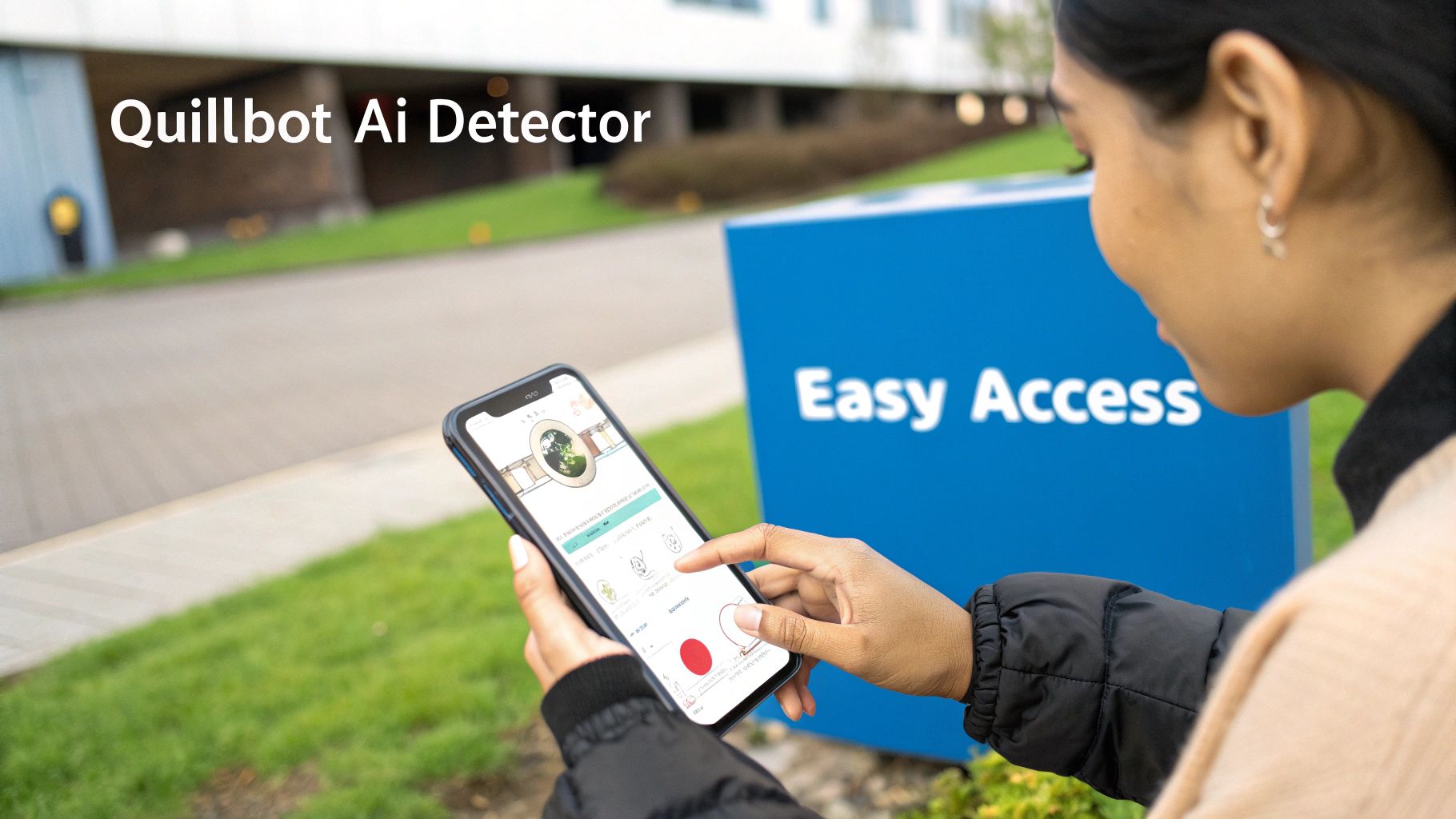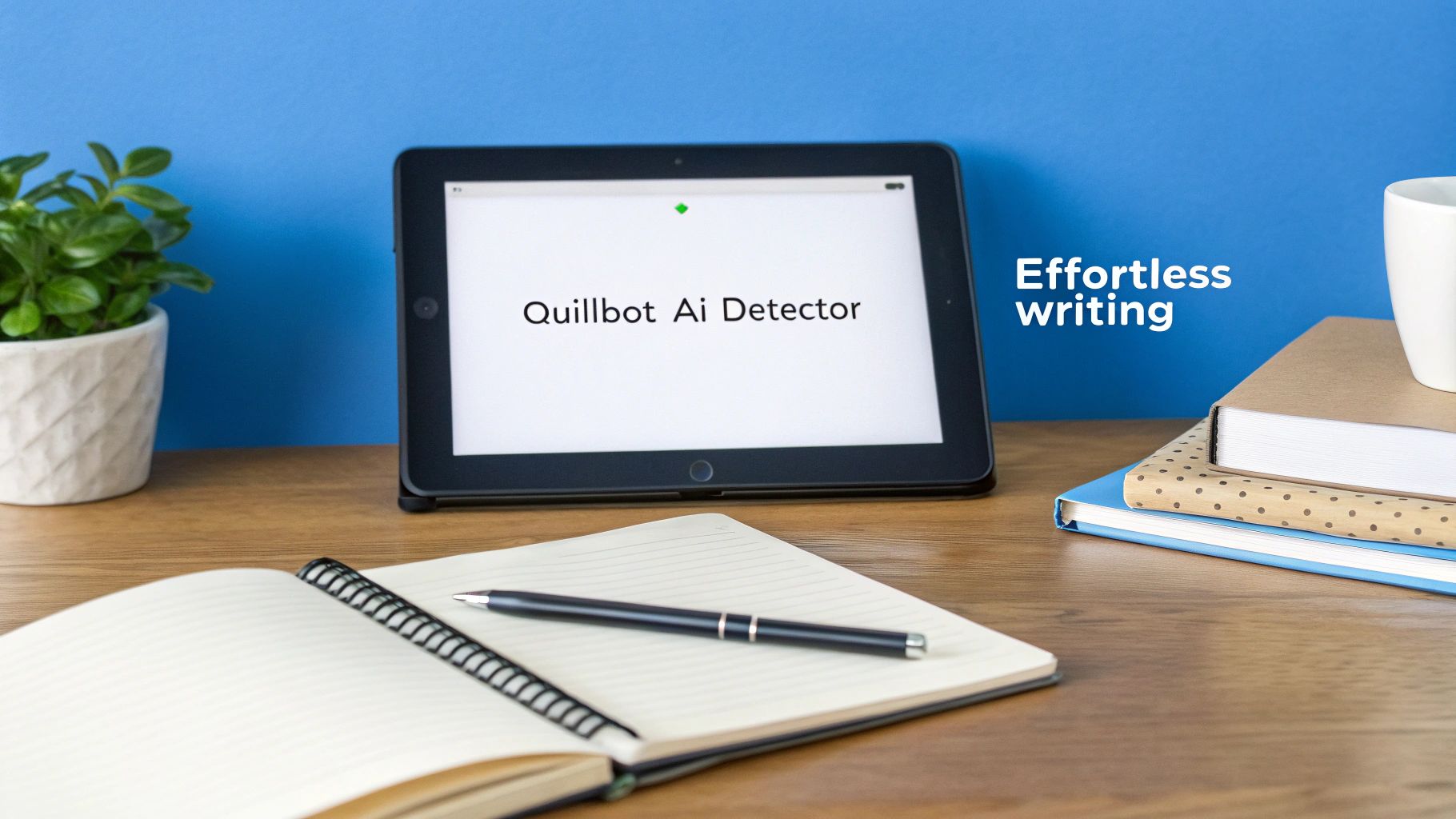The Evolution and Core Technology Behind QuillBot's AI Detector

QuillBot started as a paraphrasing tool but has grown to include an AI detection system, responding to the increasing need to distinguish between human and machine-written text. This evolution shows how the tool has adapted to help users identify AI-generated content through advanced analysis methods.
Pattern Recognition and Linguistic Markers
The AI detector examines text by looking for specific writing patterns and language markers. It analyzes elements like repeated phrases and overly formal language that commonly appear in AI writing. Beyond individual words, the system evaluates how sentences connect and flow together, checking if the text reads naturally or shows signs of artificial generation.
The Database and Comparison Process
The system works from an extensive collection of AI writing samples and patterns. When analyzing text, it matches the input against these known examples to spot similarities. The size of this reference database directly affects how well the detector can identify AI content – more samples mean better detection accuracy. However, this approach also means the system needs constant updates to recognize new AI writing styles.
Key Indicators of AI-Generated Content
The detector looks at several main factors to spot AI writing. First, it checks how predictable the text patterns are, since AI often follows more regular structures than humans. It also looks for signs of true originality in ideas and insights, which AI typically struggles to produce. Another telling sign is how sentence length and structure vary – human writers naturally mix up their sentence patterns, while AI tends to be more uniform.
Recent Updates and Enhanced Capabilities
QuillBot regularly improves its detector through updates focused on accuracy and reducing false positives. These improvements often involve adding new writing patterns to the database and fine-tuning the detection algorithms. As AI writing tools become more advanced, these updates help the detector stay effective. User feedback plays an important role in these improvements, helping QuillBot adjust the system to better meet real-world needs.
Real-World Performance and Success Metrics
The QuillBot AI detector, launched in July 2024, aims to identify AI-generated text, but its real-world effectiveness requires careful examination. For content creators and educators focused on authenticity, understanding how well this tool actually performs means looking beyond marketing claims to evaluate independent testing data and user experiences.
Accuracy Across Content Types
Testing by independent researchers shows the Quillbot AI detector achieves around 80% accuracy in identifying AI content, though results vary significantly by content type. Technical writing with structured patterns tends to produce more reliable detection results, as the system excels at identifying AI's predictable patterns in specialized fields. However, creative formats like poetry or narrative fiction pose greater challenges, where the nuanced nature of human expression can lead to less accurate assessments.
The Issue of False Positives
A key concern emerging from practical use is the frequency of human-written text being incorrectly identified as AI-generated. This creates serious problems, especially in academic settings where original work is essential. For example, a student who writes an authentic essay could face unwarranted scrutiny if the detector incorrectly flags their work. These scenarios highlight why the detector should serve as just one tool among many for evaluating content authenticity. You might be interested in: How to master content authenticity.
Impact of Writing Style
Writing style significantly affects detection accuracy. Authors who naturally write in a structured, methodical way may trigger more false positives since their style shares common patterns with AI-generated text. The detector searches for specific writing characteristics – if a human writer happens to use similar patterns, their work might be mistakenly flagged. This reinforces the need to carefully interpret results while considering individual writing approaches.
Case Studies and User Strategies

Professional users have developed practical methods for working with the detector's strengths and limitations. Many adopt a multi-tool approach, combining the detector with other verification methods and expert review. Others focus on understanding the tool's specific limitations within their content areas to better interpret results. These real experiences show how detector use has matured from simple reliance to informed application. For instance, educators now use it as a teaching tool to help students understand AI text characteristics rather than just for catching violations. This reflects growing awareness of both the benefits and constraints of AI detection technology.
Making Sense of Premium Features and Pricing
Now that we've explored how well QuillBot AI detector performs, let's break down the different service tiers and what you get with each one. Understanding these options will help you choose the version that makes the most sense for your needs.
Decoding the Free Tier
The free version of QuillBot AI detector gives you a basic way to check if content was AI-generated. You can analyze up to 1,000 words at a time, which works well for emails, social posts, and short articles. While this free version lets you try out the tool's core features, it does have some key limitations. Testing shows it's about 65% accurate – helpful for initial screening but not perfect. This means you might get some false positives or miss some AI-generated content.
Unveiling the Premium Advantages
When you need to analyze longer pieces or want more reliable results, QuillBot's premium tiers offer expanded capabilities. These paid versions let you check much longer texts – from 10,000 up to 50,000 words – making them ideal for academic papers and business documents. The premium versions also improve accuracy rates up to 90%. For instance, if you're checking student papers or verifying important business content, this higher accuracy becomes essential. With a premium subscription, you can confidently analyze more text with better reliability.
Feature Comparison and Cost Breakdown
The pricing tiers accommodate different usage needs. For example, the $19.99 plan works well for checking shorter documents, while the $49.99 tier handles documents over 50,000 words – perfect for organizations processing lots of content. This tiered approach helps you pay only for what you'll actually use. However, user feedback on platforms like Reddit points out that even premium users sometimes get false results. So while the paid tiers definitely improve the experience, it's good to maintain realistic expectations. For more details on getting the most from your subscription, see our guide on managing your QuillBot subscription.
Strategic Investment for Maximum Value
Your ideal tier depends heavily on how you plan to use the tool. Students checking occasional assignments might do fine with the free version. But if you regularly work with long documents or need high accuracy – like teachers reviewing papers or content creators verifying work – the premium features become much more valuable. When deciding, consider both the immediate cost and how the tool will impact your workflow over time. Understanding exactly what each tier offers helps ensure you choose the option that delivers the best results for your specific situation.
Navigating Common Challenges and Limitations

QuillBot's AI detector provides useful capabilities, but knowing its constraints helps users get the most accurate results. Being aware of these limitations allows content teams to develop better verification strategies and avoid common mistakes when checking content authenticity.
Word Count Restrictions and Practical Workarounds
The free version of QuillBot's AI detector has a notable limitation – it can only analyze up to 1,000 words at once. For longer documents like research papers or detailed reports, users need to split content into smaller segments, which can slow down the review process. Many content teams have found ways to work around this by focusing first on sections most likely to contain AI-generated text, such as methodology descriptions or technical explanations. Some teams opt for premium plans to analyze longer texts, though these versions also have maximum word limits.
Addressing Accuracy Variations Across Content Types
Test results show that the detector's accuracy varies depending on the type of writing being analyzed. For example, it tends to perform better with technical content that follows standard patterns and formatting. However, creative writing like poetry or narrative fiction can be more challenging for the tool to assess accurately. The detector sometimes flags complex human-written sentences as potentially AI-generated because of their unique structure or unusual phrasing. This makes it important to consider the specific genre when reviewing results rather than taking the detection scores at face value.
Developing Reliable Verification Workflows
Since false positives can occur and the tool has inherent limitations, using multiple verification methods produces better results. Rather than relying solely on QuillBot's detector, consider combining it with other checking tools and human review. This multi-step approach works similarly to fact-checking news stories – getting confirmation from several sources provides a more complete picture than using just one tool. Set up a systematic process that includes both automated and manual review steps.
Expert Tips for Cross-Validation and Result Interpretation
When reviewing QuillBot's detection results, treat high AI probability scores as indicators for further investigation rather than definitive proof. Compare flagged sections against other AI detection tools and analyze them manually for inconsistencies in writing style. Consider the writer's normal voice and patterns – sudden changes could suggest AI assistance. Look for specific characteristics like awkward phrasing or unnatural transitions in passages marked as potentially AI-generated. Following these practices helps teams use the detector effectively as part of a thorough content verification process.
Professional Insights and Implementation Strategies
Content managers, educators, and publishers have found practical ways to incorporate the QuillBot AI detector into their workflows. Their real-world experience provides valuable insights into making the most of this tool while being mindful of its limitations.
Content Management and Quality Assurance
For content managers tasked with maintaining high editorial standards, the QuillBot AI detector serves as a useful initial screening tool. When reviewing submissions from freelance writers, running articles through the detector helps identify potential AI-generated content that warrants closer examination. This focused approach saves time by directing quality assurance efforts where they're most needed, while helping to establish clear expectations around original content creation within teams.
Educational Applications and Academic Integrity
In academic settings, educators often use the QuillBot AI detector as one component of a broader approach to upholding academic integrity. The tool provides an initial check of student submissions to flag possible AI-generated text for further investigation. However, experienced educators know not to rely solely on automated detection – they combine tool outputs with their professional judgment and traditional plagiarism checks. This balanced methodology helps guide students toward responsible use of AI writing tools while maintaining academic standards.
Publishing and Content Verification
Publishing houses face constant pressure to verify the authenticity of manuscripts and other content. The QuillBot AI detector adds a valuable verification step, particularly when processing high volumes of submissions. Publishers can quickly scan incoming manuscripts to identify sections that may require additional scrutiny. This proactive quality control helps protect their reputation while encouraging writers to prioritize original work.
Building a Robust Content Verification Process
Leading organizations recognize that effective content verification requires multiple complementary approaches. The most successful verification workflows typically include:
- Initial Screening with QuillBot AI Detector: Using the tool to identify passages that merit closer review
- Cross-Referencing with Other AI Detectors: Comparing results across multiple detection tools to minimize false positives and negatives
- Manual Review by Human Experts: Having experienced editors examine flagged content for subtle indicators that automated tools might miss
- Stylistic Analysis and Contextual Evaluation: Assessing the overall flow, consistency and coherence of the writing in context
- Ongoing Monitoring and Refinement: Regularly evaluating and updating verification processes based on evolving AI writing capabilities
By combining automated tools like the QuillBot AI detector with human expertise and judgment, organizations can develop comprehensive content verification practices that promote authenticity and build trust. This layered approach acknowledges both the value and limitations of AI detection tools while maintaining focus on quality content that serves readers' needs. Regular assessment and refinement of these practices ensures they remain effective as AI writing technology continues to advance.
Maximizing Detection Accuracy and Alternative Approaches

Getting the most out of the QuillBot AI detector requires more than just running text through the tool. To truly identify AI-generated content effectively, you need to understand the tool's limitations and use additional verification methods. The percentage score alone doesn't tell the full story, especially since false positives can occur. This section examines proven techniques for improving detection accuracy and creating better content verification systems.
Understanding the Limits of Automated Detection
Like other AI detection tools, the QuillBot detector isn't perfect. While it typically achieves around 80% accuracy, performance can vary based on writing style and content type. The tool sometimes flags human-written text as AI-generated, which is a key limitation to keep in mind. Think of it as similar to a spell checker – it helps spot potential issues but requires human judgment for final decisions. The detector works best as one piece of evidence rather than the sole determining factor.
Developing a Multi-Layered Verification Process
For best results, integrate the QuillBot detector into a broader verification system that uses multiple tools and approaches. For example, check content against several AI detectors to identify any inconsistencies and reduce both false positives and false negatives. This is similar to getting a second medical opinion – an extra check that provides more confidence in the results.
The Power of Human Review
While automated tools play an important role, skilled human reviewers add essential nuanced analysis that AI detectors can't replicate. Experienced editors can identify subtle signs like inconsistent writing styles, gaps in logic, and other indicators that automated tools might miss. This human element is especially crucial for creative writing, where AI detectors may misinterpret the natural variations in human expression. You might be interested in: How to master content authenticity with AI tools.
Building a Robust Verification Workflow
An effective content verification process should include these key components:
- Initial Screening with QuillBot: Start with a basic scan to flag potential AI-generated sections
- Cross-Referencing: Check results using multiple reputable AI detection tools
- Human Evaluation: Have skilled editors review flagged content in detail
- Contextual Analysis: Consider the writer's usual style and the content's purpose
- Ongoing Refinement: Update your verification methods as AI writing technology advances
This multi-step approach ensures more accurate and thorough content authenticity checks.
SmartStudi for Complete Content Verification
SmartStudi offers AI-powered tools for improving your content creation and verification. The platform includes AI detection, plagiarism checking, paraphrasing help, and grammar correction features to ensure high-quality, authentic content. Visit SmartStudi today to see how it can help you create and verify content with confidence. Visit SmartStudi
